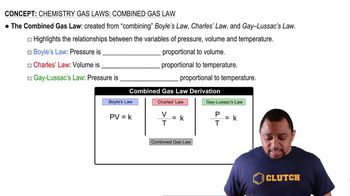Use the van der Waals equation and the ideal gas equation to calculate the volume of 1.000 mol of neon at a pressure of 500.0 atm and a temperature of 355.0 K. Explain why the two values are different. (Hint: One way to solve the van der Waals equation for V is to use successive approximations. Use the ideal gas law to get a preliminary estimate for V.)
Ch.6 - Gases

Chapter 6, Problem 95
Modern pennies are composed of zinc coated with copper. A student determines the mass of a penny to be 2.482 g and then makes several scratches in the copper coating (to expose the underlying zinc). The student puts the scratched penny in hydrochloric acid, where the following reaction occurs between the zinc and the HCl (the copper remains undissolved): Zn(s) + 2 HCl(aq)¡ H2( g) + ZnCl2(aq) The student collects the hydrogen produced over water at 25 °C. The collected gas occupies a volume of 0.899 L at a total pressure of 791 mmHg. Calculate the percent zinc (by mass) in the penny. (Assume that all the Zn in the penny dissolves.)
 Verified step by step guidance
Verified step by step guidance1
Determine the partial pressure of hydrogen gas by subtracting the vapor pressure of water at 25 °C from the total pressure. Use the vapor pressure of water at 25 °C, which is 23.8 mmHg.
Convert the partial pressure of hydrogen gas from mmHg to atm using the conversion factor: 1 atm = 760 mmHg.
Use the ideal gas law, PV = nRT, to calculate the number of moles of hydrogen gas (n). Use R = 0.0821 L·atm/mol·K and convert the temperature to Kelvin by adding 273.15 to the Celsius temperature.
Use the stoichiometry of the balanced chemical equation to determine the moles of zinc that reacted. Since 1 mole of Zn produces 1 mole of H2, the moles of Zn are equal to the moles of H2.
Calculate the mass of zinc using the moles of zinc and the molar mass of zinc (65.38 g/mol). Then, calculate the percent zinc by mass in the penny using the formula: (mass of Zn / total mass of penny) * 100%.

Verified video answer for a similar problem:
This video solution was recommended by our tutors as helpful for the problem above.
Video duration:
7mWas this helpful?
Key Concepts
Here are the essential concepts you must grasp in order to answer the question correctly.
Stoichiometry
Stoichiometry is the calculation of reactants and products in chemical reactions. It involves using balanced chemical equations to determine the relationships between the amounts of substances consumed and produced. In this case, stoichiometry will help relate the volume of hydrogen gas produced to the amount of zinc that reacted with hydrochloric acid.
Recommended video:
Guided course

Stoichiometry Concept
Gas Laws
Gas laws describe the behavior of gases under various conditions of temperature and pressure. The Ideal Gas Law (PV=nRT) is particularly useful for calculating the number of moles of gas produced in a reaction. In this scenario, the total pressure of the collected hydrogen gas must be adjusted for water vapor pressure to find the effective pressure of the hydrogen, which is essential for determining the moles of hydrogen produced.
Recommended video:
Guided course

Combined Gas Law
Percent Composition
Percent composition is a way to express the mass percentage of each element in a compound or mixture. It is calculated by dividing the mass of the element by the total mass of the compound and multiplying by 100. In this problem, calculating the percent zinc in the penny requires determining the mass of zinc that reacted and comparing it to the total mass of the penny.
Recommended video:
Guided course

Mass Percent Calculation
Related Practice
Textbook Question
1
views
Textbook Question
Use the van der Waals equation and the ideal gas equation to calculate the pressure exerted by 1.000 mol of Cl2 in a volume of 5.000 L at a temperature of 273.0 K. Explain why the two values are different.
Textbook Question
A 2.85-g sample of an unknown chlorofluorocarbon decomposes and produces 564 mL of chlorine gas at a pressure of 752 mmHg and a temperature of 298 K. What is the percent chlorine (by mass) in the unknown chlorofluorocarbon?
Textbook Question
The mass of an evacuated 255 mL flask is 143.187 g. The mass of the flask filled with 267 torr of an unknown gas at 25 °C is 143.289 g. Calculate the molar mass of the unknown gas.
